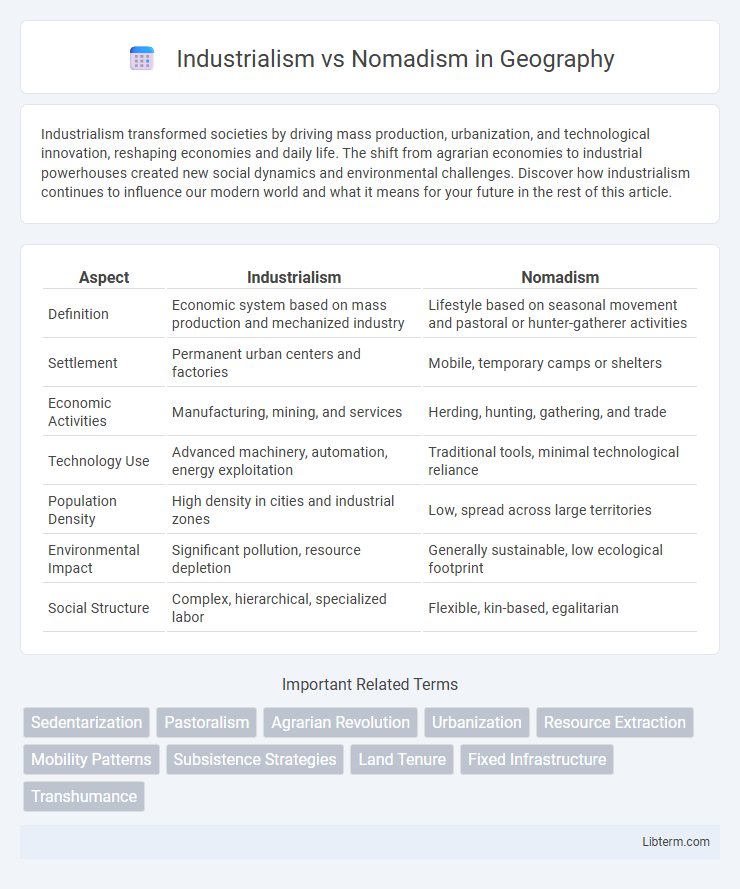Industrialism transformed societies by driving mass production, urbanization, and technological innovation, reshaping economies and daily life. The shift from agrarian economies to industrial powerhouses created new social dynamics and environmental challenges. Discover how industrialism continues to influence our modern world and what it means for your future in the rest of this article.
Table of Comparison
| Aspect | Industrialism | Nomadism |
|---|---|---|
| Definition | Economic system based on mass production and mechanized industry | Lifestyle based on seasonal movement and pastoral or hunter-gatherer activities |
| Settlement | Permanent urban centers and factories | Mobile, temporary camps or shelters |
| Economic Activities | Manufacturing, mining, and services | Herding, hunting, gathering, and trade |
| Technology Use | Advanced machinery, automation, energy exploitation | Traditional tools, minimal technological reliance |
| Population Density | High density in cities and industrial zones | Low, spread across large territories |
| Environmental Impact | Significant pollution, resource depletion | Generally sustainable, low ecological footprint |
| Social Structure | Complex, hierarchical, specialized labor | Flexible, kin-based, egalitarian |
Understanding Industrialism: Definition and Core Principles
Industrialism is an economic and social system characterized by the large-scale production of goods using machinery and advanced technology, leading to urbanization and factory-based work environments. Core principles include mechanization, mass production, specialization of labor, and reliance on fossil fuels to drive industrial processes. This system contrasts sharply with nomadism, which emphasizes mobility, subsistence-based livelihoods, and minimal environmental impact.
The Essence of Nomadism: A Lifestyle Overview
Nomadism embodies a lifestyle rooted in constant movement, emphasizing adaptability and resourcefulness to thrive in diverse environments. Unlike industrialism's fixed infrastructure and mass production, nomadic life prioritizes intimate knowledge of nature, communal living, and sustainable resource use. This essence of nomadism fosters resilience and cultural continuity through generational transmission of skills and traditions.
Historical Evolution: From Nomadic Tribes to Industrial Societies
Nomadism characterized early human societies with their reliance on hunting, gathering, and seasonal migration to sustain livelihoods, promoting fluid social structures and adaptability. The advent of agriculture around 10,000 BCE enabled sedentary communities, leading to permanent settlements and the eventual rise of complex civilizations, setting the stage for the Industrial Revolution in the 18th century. Industrialism introduced mechanized production, urbanization, and economic specialization, fundamentally transforming social organization, labor systems, and technological advancement, marking a profound historical evolution from nomadic to industrial societies.
Economic Structures: Production, Consumption, and Exchange
Industrialism centers on mass production through mechanized factories, enabling high-volume consumption and facilitating complex market exchanges via monetary systems. Nomadism relies on subsistence production, predominantly through hunting, gathering, or pastoralism, with consumption based on immediate use and exchange often occurring through barter or reciprocal arrangements. Economic structures in industrialism emphasize efficient resource allocation and market integration, whereas nomadic economies prioritize mobility and adaptability within resource-scarce environments.
Social Organization and Community Life
Industrialism structures social organization through hierarchical institutions and specialized labor roles, fostering large, densely populated urban communities with complex bureaucratic systems. Nomadism emphasizes fluid social organization based on kinship and clan ties, supporting small, mobile groups that rely on shared resources and egalitarian decision-making. Community life in industrial societies is often characterized by formal institutions and economic interdependence, while nomadic groups maintain close-knit, adaptable relationships centered on mutual support and cultural traditions.
Environmental Impact: Sustainability and Resource Use
Industrialism drives resource extraction and energy consumption at unprecedented scales, often leading to habitat destruction, pollution, and carbon emissions that exacerbate climate change. Nomadism relies on sustainable resource use through cyclical movement patterns, allowing ecosystems to regenerate and minimizing environmental degradation. The contrasting environmental impact highlights industrialism's challenges in achieving sustainability compared to nomadism's adaptive harmony with natural resource limits.
Technological Advancements and Adaptation
Industrialism drives technological advancements through centralized manufacturing and mechanization, fostering rapid innovation in machinery, transportation, and communication. Nomadism emphasizes adaptive technologies tailored for mobility and environmental resilience, such as lightweight tools, portable shelters, and sustainable resource management. The contrast lies in industrialism's reliance on complex infrastructure versus nomadism's emphasis on flexibility and ecological harmony.
Mobility vs Settlement: The Human Geography Factor
Industrialism fosters permanent settlements through urbanization driven by factories, infrastructure, and economic concentration, shaping dense human geography patterns and reduced mobility. Nomadism emphasizes high mobility, with populations consistently relocating to exploit seasonal resources, resulting in dispersed, flexible spatial distribution and minimal environmental impact. The contrast between industrialism's fixed infrastructure and nomadism's mobile lifestyle highlights fundamental differences in how humans interact with land, resources, and social organization.
Cultural Values: Tradition, Identity, and Innovation
Industrialism emphasizes innovation and technological advancement, often reshaping cultural values towards progress and efficiency while challenging traditional practices. Nomadism prioritizes tradition and identity through close ties to ancestral customs, landscape, and community, preserving cultural continuity despite mobility. The dynamic tension between industrial innovation and nomadic tradition shapes diverse socio-cultural identities and influences adaptation strategies.
The Future: Blending Industrial and Nomadic Lifestyles
The future of lifestyle evolution envisions a dynamic integration of industrialism and nomadism, fostering flexibility and sustainability. Advanced technologies like remote work platforms and smart infrastructure enable individuals to maintain productivity while embracing mobility. This hybrid model promotes economic growth alongside environmental stewardship, reshaping urban planning and social structures worldwide.
Industrialism Infographic

 libterm.com
libterm.com